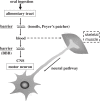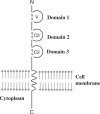Molecular aspects of poliovirus pathogenesis
- PMID: 24367151
- PMCID: PMC3859295
- DOI: 10.2183/pjab/83.266
Molecular aspects of poliovirus pathogenesis
Abstract
The development of a transgenic mouse model carrying the human poliovirus receptor has made it possible to investigate the molecular mechanisms of the viral dissemination process in a whole organism. Studies on this have provided an insight into the mechanisms for viral permeation through the blood-brain barrier and retrograde axonal transport of the virus. In addition, strain-specific neurovirulence levels are shown to depend mainly on the replicating capacity of the virus in the central nervous system rather than the efficiency of the 2 dissemination pathways indicated above. Studies of poliovirus-induced cytopathic effects on neural cells revealed that neural cells possess anti-poliovirus characteristics that may offer a new avenue for investigating the molecular mechanisms of poliovirus neurovirulence.
Keywords: dissemination; neurovirulence; poliovirus; poliovirus receptor; transgenic mouse.
Figures













Similar articles
-
Recent insights into poliovirus pathogenesis.Trends Microbiol. 2001 Oct;9(10):501-6. doi: 10.1016/s0966-842x(01)02200-4. Trends Microbiol. 2001. PMID: 11597452 Review.
-
The molecular basis of poliovirus neurovirulence.Dev Biol (Basel). 2001;105:51-8. Dev Biol (Basel). 2001. PMID: 11763337
-
Retrograde transport of intact poliovirus through the axon via the fast transport system.Virology. 1998 Oct 10;250(1):67-75. doi: 10.1006/viro.1998.9360. Virology. 1998. PMID: 9770421
-
Transgenic mice carrying the human poliovirus receptor: new animal models for study of poliovirus neurovirulence.J Virol. 1994 Feb;68(2):681-8. doi: 10.1128/JVI.68.2.681-688.1994. J Virol. 1994. PMID: 8289371 Free PMC article.
-
[Analysis of dissemination pathways for poliovirus].Uirusu. 2009 Jun;59(1):107-14. doi: 10.2222/jsv.59.107. Uirusu. 2009. PMID: 19927995 Review. Japanese.
Cited by
-
Genetic and phenotypic stability of poliovirus shed from infants who received novel type 2 or Sabin type 2 oral poliovirus vaccines in Panama: an analysis of two clinical trials.Lancet Microbe. 2022 Dec;3(12):e912-e921. doi: 10.1016/S2666-5247(22)00254-3. Epub 2022 Nov 1. Lancet Microbe. 2022. PMID: 36332645 Free PMC article.
-
Crystal structures of the 3C proteases from Coxsackievirus B3 and B4.Acta Crystallogr F Struct Biol Commun. 2024 Aug 1;80(Pt 8):183-190. doi: 10.1107/S2053230X24006915. Epub 2024 Jul 25. Acta Crystallogr F Struct Biol Commun. 2024. PMID: 39052022 Free PMC article.
-
Enteroviral proteases: structure, host interactions and pathogenicity.Rev Med Virol. 2016 Jul;26(4):251-67. doi: 10.1002/rmv.1883. Epub 2016 May 4. Rev Med Virol. 2016. PMID: 27145174 Free PMC article. Review.
-
Neurological Damage by Coronaviruses: A Catastrophe in the Queue!Front Immunol. 2020 Sep 10;11:565521. doi: 10.3389/fimmu.2020.565521. eCollection 2020. Front Immunol. 2020. PMID: 33013930 Free PMC article. Review.
-
Prevalence of vaccine-derived poliovirus in sewage waters in Maiduguri, Borno State, Nigeria.Infez Med. 2024 Mar 1;32(1):90-98. doi: 10.53854/liim-3201-12. eCollection 2024. Infez Med. 2024. PMID: 38456020 Free PMC article.
References
-
- Mendelsohn, C.L., Wimmer, E. and Racaniello, V.R. (1989) Cellular receptor for poliovirus: molecular cloning, nucleotide sequence, and expression of a new member of the immunoglobulin superfamily. Cell 56, 855–865 - PubMed
-
- Ren, R., Constantini, F., Gorgacz, E.J., Lee, J.J. and Racaniello, V.R. (1990) Transgenic mice expressing a human poliovirus receptor: a new model for poliomyelitis. Cell 63, 353–362 - PubMed
-
- Bodian, D. (1955) Emerging concept of poliomyelitis infection. Science 122, 105–108 - PubMed
Publication types
LinkOut - more resources
Full Text Sources
Research Materials
